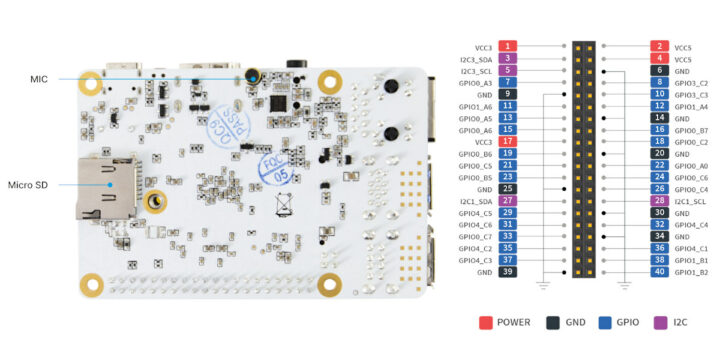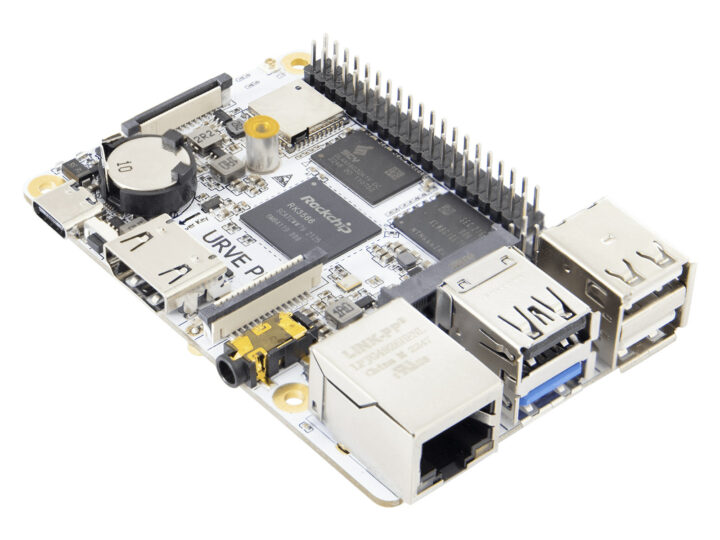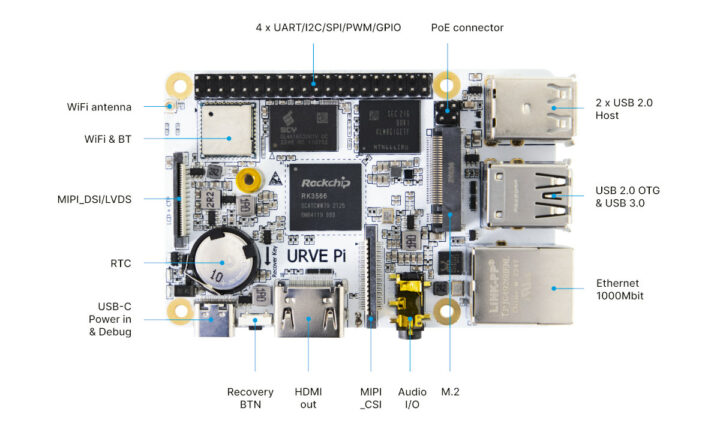URVE Board Pi is a single board computer (SBC) powered by a Rockchip RK3566 quad-core Cortex-A55 processor, 2GB RAM, 8GB eMMC flash, plus the same interfaces as the Raspberry Pi 3 Model B as well as an RTC with a coin-cell battery and an M.2 SSD socket.
More specifically, the Rockchip RK3566 board comes with a 4Kp60 capable HDMI 2.0 port, a MIPI DSI/LVDS display interface, a MIPI CSI camera connector, Gigabit Ethernet, four USB 3.0/2.0 ports, a dual-band WiFi 5.0 and Bluetooth 4.2 wireless module, and the usual 40-pin GPIO header.
- SoC – Rockchip RK3566 Quad Core Cortex-A55 processor @ 1.8 GHz with Arm Mali-G52 GPU, 0.8 TOPS NPU
- System Memory – 2GB LPDDR4 (up to 8GB)
- Storage
- 8GB eMMC flash (up to 128GB)
- M.2 PCIe socket for 2242 NVMe SSD
- MicroSD card slot
- Video Output
- HDMI 2.0 with HDCP 1.4/2.2, up to 4Kp60
- 4-lane MIPI DSI to 2560×1440 @ 60Hz or LVDS up to 1080p60
- Audio – 3.5mm Stereo audio jack, built-in microphone
- Camera I/F – MIPI CSI input
- Networking
- Gigabit Ethernet RJ45 port
- Dual 2.4GHz/5GHz WiFi 5 (802.11 a/b/g/n/ac) and Bluetooth 4.2
- USB – 1x USB 3.0 port, 2x USB 2.0 ports, 1 USB 2.0 OTG port (black), 1x USB Type-C port for power and debugging
- Expansion
- 40-pin Raspberry Pi-compatible header with 3x I2C (up to 400 kbps), 2x SPI, 4x UART, 10 PWM, 1x ADC (TBC)
- 1x M.2 PCIe socket for SSD
- Misc – Recovery button, 2x LEDs, RTC with battery
- Power Supply
- 5V/2A via USB-C port
- PoE connector
- Temperature Range – 0°C ~ 70°C (no condensation)
- Dimensions – 85 x 56 mm
- Weight – 50 grams

The company provides Android 11 and Debian 11 OS images for the board plus “URVE multimedia software” designed for digital signage applications. Note there is some confusion in the specs as SATA or PCIe show up interchangeably on the company’s website, but the user manual shows “/dev/nvme0n1” SSD so it’s definitely a PCIe/NVMe SSD, although the way Rockchip RK3566 is designed it might be possible to switch between SATA and PCIe since the interface are multiplexed. But URVE does not make any claims about this feature.
The added features against the Raspberry Pi 3 or 4 SBC are the built-in eMMC flash storage, the real-time clock (RTC) with a backup battery, the M.2 SSD socket, and a 0.8 TOPS NPU that enables running accelerated machine learning or artificial intelligence workloads without an external AI accelerator. The MIPI DSI can also take an LVDS display beyond just supporting DSI displays.
URVE multimedia software shown with a 10-inch display (not URVE Board Pi)
You’ll find a product brief, a user manual, OS images, and tools on the product page. The board is designed in Poland, so it may be interesting to European customers since customs handling and VAT issues will be taken care of, and the URVE Board Pi can be purchased on BricoGeek or TME for around 85 to 95 Euros ex. VAT. [Update: the URVE Pi SBC appears to be based on the Boardcon Compact3566 SBC we covered last year. See comments section for details]
Via LinuxGizmos

Jean-Luc started CNX Software in 2010 as a part-time endeavor, before quitting his job as a software engineering manager, and starting to write daily news, and reviews full time later in 2011.
Support CNX Software! Donate via cryptocurrencies, become a Patron on Patreon, or purchase goods on Amazon or Aliexpress






